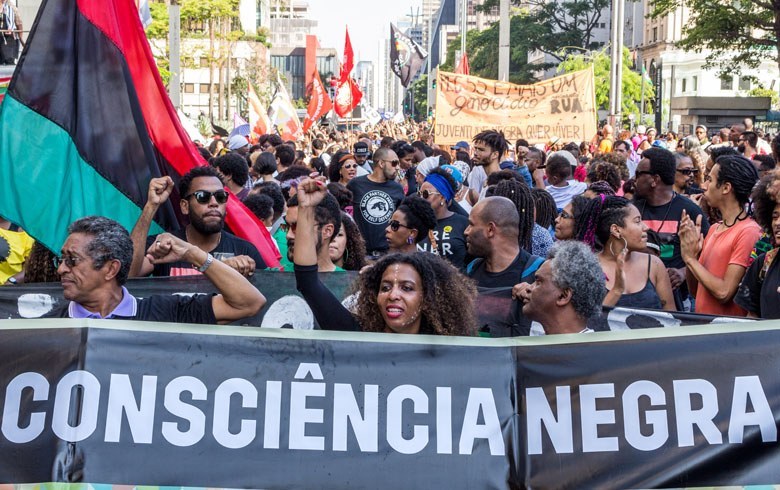Learning to Transgress: Law 10.639 and Teacher-Training Classrooms in São Paulo, Brazil
Transforming Anthropology
Volume 24, Issue 1, April 2016
Pages 70–79
DOI: 10.1111/traa.12058
Reighan Gillam, Assistant Professor of Anthropology
University of Southern California
Signed in 2003, Law 10.639 makes teaching Afro-Brazilian history and culture compulsory in primary school lessons. Training programs to educate teachers on this material have proliferated in the state of São Paulo and elsewhere in Brazil. This paper illuminates non-elite Brazilians’ lived, personal engagements with ideas of racial inequality by way of these training programs. Participants in these classrooms did not express direct rejection or acceptance of these ideas but rather relied on personal experiences to negotiate their conceptions of racial identity and racial inequality that deviate from traditional ideas of racial democracy. As Brazil takes further steps to consider race when facilitating access to resources and confronting racial inequality directly, it is imperative that the everyday iterations of this shift are understood.
As part of a series of training sessions1 to instruct teachers on how to integrate Afro-Brazilian history and culture into their curricula, trainer Flávia Gomes2 screened clips from the film Everyone’s Heroes (Heróis de Todo Mundo). This movie features prominent Afro-Brazilians and explains their role in national history. Flávia told the teachers that they could show this movie in their classrooms, or they could integrate the information from the movie into their lessons. Five female educators and I sat at our desks and quietly watched the clips that briefly recounted the lives and accomplishments of figures like Auta da Souza, an Afro-Brazilian writer, and Milton Santos, an Afro-Brazilian geographer. After showing the video, Flávia said a few words: “Violence is to whiten Black heroes. This silences the place of Blackness in the classroom. Machado de Assis, Lima Barreto. There is no way to silence this. (Não da para silenciar).” One of the participants raised her hand; Flávia called on her. She was a principal at an elementary school and participating in these classes to oversee the curricular changes at her school. Before saying anything, she began to sob, taking the entire class by surprise. “I feel so troubled because I didn’t know these people had been left out. I have heard of them but didn’t know they were Black. I liked reading the poems of Auta da Souza, but I always pictured her as White. The lack of information that we have…” Her comments trailed off as she wiped her tears. This response occurred toward the end of class, leaving Flávia with little time to initiate a conversation. Instead, she concluded class by adding a few words about using this video to educate children about the people presented in the movie before dismissing everyone for the day.
This scene played out in a teacher-training program in its first year in Flor do Campo, Brazil, in the state of São Paulo. These teacher-training programs resulted from the passage of Law 10.639, which made Afro-Brazilian history and culture compulsory material for all Brazilian public primary schools. Since its passage, teacher-training programs have proliferated throughout the country to provide teachers with classroom material about Afro-Brazilian history and culture to satisfy the legal mandate of Law 10.639. The teacher-training classrooms in which I participated were dynamic spaces of conversation, interaction, and engagement where Brazilians, like the principal above, could encounter new ways of thinking about race2 that run contrary to the common belief that racism cannot naturally exist in a mixed-race society. This article aims to examine changing understandings of race in Brazil, not as it transforms larger social and political structures, but as it is continuously reframed on the micro-social or everyday level. I argue that the critical practice of learning about and responding to subjugated knowledge and alternative experiences have the potential to transgress boundaries of belonging and recognition of racial difference in Brazil.
This article takes as a point of departure the issue of the personal in an era of changing conceptions of Brazilian race relations. This shift involves not only the macro changes of law and policy but also the personal, lived, everyday interactions of particular people as well. It uses the personal anecdotes, stories, and conversations of Brazilians offered during teacher-training sessions to examine how social change is a personal matter and how it plays out within everyday interactions. The “personal” broadly references the lived experiences of human beings. In several instances, the personal becomes the prism through which people perceive or react to macro-structural events and changing environments. I suggest that many Brazilians offer more personal responses to the shift from racial democracy based on their local and particular experiences as a way to account for the changes they are confronting in classroom education. While I would not say that these conversations were always successful at producing a shared understanding of the ways in which inequality can be tracked along racial lines, these teacher-training classrooms became sites and spaces of struggle over the limits and meanings of racial democracy and racial recognition, informed by the participants’ personal experiences of race that they frequently voiced….
Read the entire article here.





